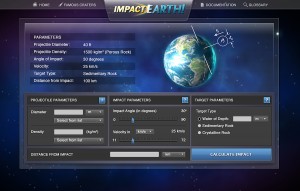
The parameters screen of the "Impact: Earth!" website allows users to input the diameter and density of the projectile, the impact angle and velocity, and whether the projectile will hit water or rock. (Information Technology at Purdue image/Michele Rund)
In dealing with asteroids that could cause damage to people and property, Earth has a blind spot.
According to space rock expert, Jay Melosh, a distinguished professor of earth, atmospheric and planetary sciences and physics at Purdue University in West Lafayette, Indiana:
“We need to invest in telescopes that can find asteroids on Earth’s sunward side, our current blind spot, and in programs to find and track the smaller asteroids, which are less devastating but far more likely to strike us.”
Melosh points to lessons learned from the Chelyabinsk meteor, which detonated over that Russian city in February of this year. Strikes to Earth along the lines of that event are of the greatest concern for the time being, he said.
Limits to the search
“At this point we’ve found more than 90 percent of the large, civilization-ending asteroids that cross the Earth’s orbit and none are threatening us, which lets us breathe a little easier for the next 1,000 years or so…but there are limits to this search,” Melosh pointed out in a Purdue University press statement.
If we could have spotted the Chelyabinsk asteroid and had tools in place to quickly judge the impact circumstances, an evacuation of the area would have prevented numerous injuries, Melosh said. “Much like we do for hurricanes, the best option is often to get people out of harm’s way and prepare for the impact.”
Calculating concern
For his part, Melosh is now working to refine an asteroid impacts effects calculator he developed.
That calculator, “Impact: Earth!” gauges the damage an asteroid strike would cause if it struck our planet.
In a retroactive test, the calculator accurately estimated most aspects of the Russian Chelyabinsk impact, including strike zone, atmospheric blast wave and ground shaking.
Still, the calculator was slightly off in estimates of how far the air blast would reach and shatter windows within the city, Melosh added.
The scientist is working to better understand and calculate this air blast effect in a city environment and to improve the precision of other calculations.
Check out the “Impact: Earth!” calculator at:
http://www.purdue.edu/impactearth
Also, go to this short video about the calculator at:
http://www.youtube.com/watch?v=n1Uy5ye0ats
By Leonard David
